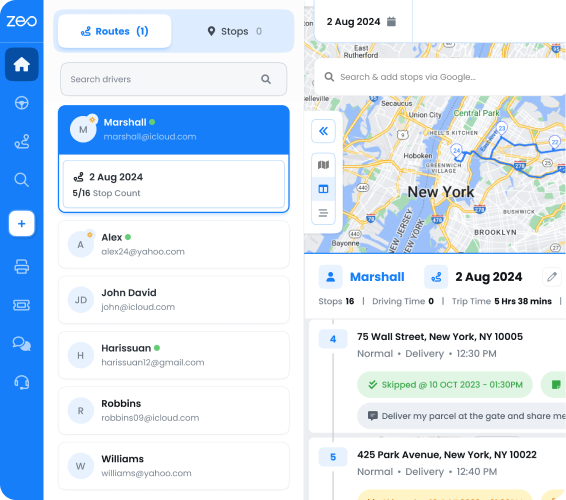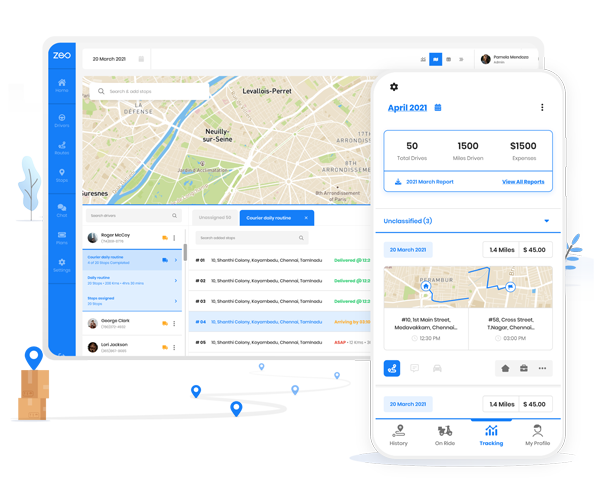Updated on: April 14, 2025
Last-mile delivery is a crucial step of the supply chain
Last-mile delivery is a crucial step of the supply chain, responsible for transporting your product to its final destination. It wasn’t easy to manage the last-mile delivery a decade ago, but technology’s involvement made handling it easy.
We have seen how the business has changed amid the COVID-19 pandemic and how the industry adopted no-contact delivery to keep itself on track. We have also seen that same-day delivery becoming the new normal after the eCommerce boom in 2021.

If you are handling the last-mile delivery, then delayed delivery times or lost packages can significantly hurt customer satisfaction and a company’s reputation if the problem persists. Proactively working to improve last-mile delivery should be a priority for all e-commerce companies.
In this post, we will be talking about last-mile delivery and the challenges faced by the people running it. We will also be looking at five ways you should follow to improve your last-mile delivery, enhancing your business, and increasing profits.
What is last-mile delivery?
Last-mile delivery is the final step of the supply chain in which the product is transported from a warehouse to the customer’s doorstep, completing its journey.
Last-mile delivery is also known as last-mile logistics, last-mile distribution, and final mile delivery. Typically the most expensive step of the supply chain, last-mile delivery often involves companies footing substantial shipping costs to provide quick and even free shipping options for customers.
In simple words, last-mile delivery is the industry that helps in delivering your ordered product from the retailer to your doorsteps. They carry out all the complex processes of getting the product to your hands in the most efficient way, and most importantly, in time.
Challenges faced in last-mile delivery
Last-mile delivery is one of the most expensive processes, and generally, it is most inefficient. This inefficiency is due to some challenges which are faced by the people handling it. Let’s look into some of these challenges.
- Traffic is one crucial challenge in the last-mile delivery business. In cities, increased traffic congestion slows down delivery times. Even though delivery points may be close in proximity, traffic hinders a driver’s ability to get from Point A to Point B within an acceptable amount of time.
- Since urban areas experience traffic, the rural areas may not experience congested traffic like a city; the distance between delivery points can span several miles. Suppose only a handful of packages are dropped off at each end. In that case, the effort to transport these items over long distances is disproportionate to the significant cost incurred to deliver a minimal product.
- The rise of e-commerce has also impacted last-mile delivery as customers’ expectations continue to set higher standards, demanding fast delivery at little-to-no cost. Additionally, due to the increase of orders as online shopping continues to rise in popularity, companies must also juggle the delivery of larger and more frequent shipments successfully.
These were some of the biggest challenges faced by the people operating the last-mile delivery; though there are many others, they constitute larger ones. Let’s now look at how you can overcome these challenges.
5 key solutions to improve last-mile delivery
By evaluating your existing last-mile delivery procedures and identifying opportunities to improve its efficiency, you will be able to provide a successful first-time delivery to your customers. It will also help you in maintaining a good customer relationship. Just follow these five simple steps to start with, and you will see the changes.
1. Establishing proper operating procedures
Establishing standard operating procedures is very important in not only last-mile delivery but in any business. If you are not following a proper strategy, then you will incur huge losses. First of all, you should begin analyzing all your data, including your load time, delivery time, driver performance, fuel costs, and many such factors.

By analyzing your records, you will get to know where your business is lacking and the points you need to improve. Training your drivers can also improve the overall performance of your delivery business. With these established standards in place, you will be able to analyze planned versus actual delivery performance.
Assessing drivers’ productivity and accountability; pinpoint areas of the delivery schedule to meet customer demands better; and identify performance gaps that will increase profitability and improve customer satisfaction when addressed.
2. Improving customer communications
The essential thing in every business is to maintain good customer service. If your customer is happy with you, in turn, you will see increased profits in your industry. To increase your customer satisfaction, you should try to improve communication with them, too, as their order is packed and transported.

Continual communication from the point of purchase to order fulfillment is essential; keep the client informed about their package’s location throughout the supply chain and final mile distribution process.
Enhanced customer communication can solve common transportation challenges and decrease customer service calls inquiring about their order status. It increases consumers’ confidence and trust in your last-mile delivery service.
3. Giving customers a priority to choose
It would be best to give customer’s a priority to choose their delivery window and many other aspects. It will help you cut down the re-deliveries that your driver will make and decrease fuel costs. Giving customer’s a little power will help your business in two ways:

increase fuel savings
Save 2 Hours on Deliveries, Everyday!
Optimize routes with our algorithm, reducing travel time and costs efficiently.
Get Started for Free
- Increasing the probability of first-time delivery: When customers are allowed to choose the delivery day and time during the checkout process, this increases the likelihood of successful first-time delivery. The customer will likely be present to receive the order. By doing so, you will save a lot of time and labor for your driver and decrease the fuel cost that is spent on re-delivery.
- Increases customer satisfaction: Customer satisfaction is considered by taking into account if their deliveries are on time or not. With customers in command of the delivery time, customer satisfaction increases since orders will be delivered precisely when and where they specified. A flexible fulfillment system that allows customers to alter delivery windows until the delivery day also increases satisfaction and the likelihood of first-time success.
4. Using an effective tracking system
To refrain from your packages getting lost or damaged, you should try to use a proper delivery tracking system. Throughout the supply chain, you should quickly and efficiently track orders from placement to delivery. It will allow you to monitor the amount of time it requires for the package to travel from Point A to Point B, then from Point B to Point C, and so on.

Packages must arrive at the consumer’s doorstep on-time to ensure customer satisfaction. Tracking all the deliveries will also help you look at your driver’s while on the roads. It will help you to know their performance, and you can also keep a check if they are following the traffic rules or not.
The tracking system will help your drivers if they meet any kind of mishappenings on the roads. You can provide help to your drivers and notify your customer about the delay that has occurred. In this way, tracking systems give you benefits in two ways.
5. Using a last-mile delivery management software
A third-party last-mile delivery management software, just like Zeo Route Planner, is an application that fulfills all your needs to handle your delivery business. It provides you with a bundle of features that you can use to manage all the complex processes of the delivery business.

Using a delivery management application can solve all the headaches of your delivery business. It will not only help you to manage the deliveries but also help you in providing a better customer experience. It would be best to find the right delivery management software and start using it to manage your delivery business.
How can Zeo Route Planner help you in handling last-mile delivery
Zeo Route Planner is the perfect solution for you if you want to manage all your last-mile delivery seamlessly and from one place. With Zeo Route Planner’s help, you can plan your deliveries easily and provide the best customer experience.
Zeo Route Planner gives you the option to import all your addresses through excel import, image capture/OCR, bar/QR code scan, pin drop on maps, and manual typing. Zeo Route Planner uses the same autocomplete feature used by Google Maps if you are using manual typing. You can import your list of addresses from Google Maps. By using these features, you can adequately plan your routes for delivery.

With the Zeo Route Planner, you get the best route optimization feature available in the market. Our efficient algorithm provides you with the best route in just 30 seconds, and it can optimize up to 500 stops at a time. With the help of optimized routes, your drivers can deliver packages quickly and efficiently while reducing fuel costs.
Zeo Route Planner also helps you in tracking all your drivers using the real-time driver monitoring feature. The dispatcher can use our web app to follow all the drivers and help them with any problem.
You also get the power to notify your customers using recipient notifications. Zeo Route Planner sends SMS and email notifications to keep them well informed about their delivery. They also get a link embedded with the SMS to our dashboard to track their packages in real-time.
Proof-of-delivery also adds an extra layer of providing a great customer experience. With the help of Zeo Route Planner, you can proof of delivery to your customers. Zeo Route Planner gives you two ways to capture proof of delivery:

- Digital Signature: You driver can use their smartphones to get the signature as proof of delivery. They can ask the customers to sign on the smartphone and capture the digital signature.
- Photograph capture: Your driver can also capture photographs as proof of delivery if the customer is not available to take the delivery. They can leave the package safely and then capture the photo of where the package was left.
Final thoughts
Towards the end, we would like to say whether you are an individual driver, small business, or a large eCommerce company, you can use Zeo Route Planner to carry out all your last-mile delivery processes. Zeo Route Planner will help you in achieving all your business goals efficiently.
We leave it up to you to decide whether you want to scale up your business or not. We are serving many customers, and they are happy with our services, and we keep on trying to bring those features that can help you manage all the delivery complications.
Try it now
Our motive is to make life easier and more comfortable for small and medium businesses. So now you are only one step away to import your excel and start away.

Are you a fleet owner?
Want to manage your drivers and deliveries easily?
Grow your business effortlessly with Zeo Routes Planner – optimize routes and manage multiple drivers with ease.

increase fuel savings
Save 2 Hours on Deliveries, Everyday!
Optimize routes with our algorithm, reducing travel time and costs efficiently.
Get Started for Free




















